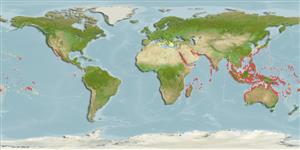Common names from other countries
Environment: milieu / climate zone / depth range / distribution range
Ecologia
; intervalo de profundidade 0 - 20 m (Ref. 348). Tropical
Indo-West Pacific and the Mediterranean: from East Africa, to Melanesia; north to South China and Taiwan Province of China and south to Indonesia; south and eastern parts of the Mediterranean. Tropical to subtropical climates.
Length at first maturity / Tamanho / Peso / Idade
Maturity: Lm ? range ? - ? cm Max length : 12.0 cm SHL macho/indeterminado; (Ref. 348); common length : 8.0 cm macho/indeterminado; (Ref. 348)
Locally collected at low tide by coastal people when abundant (Ref. 348). Attached by their strong byssus to hard substrates where mud occurs, with the shell vertically disposed and the dorsal margin lying on the rock surface, or to the underside of ledges and boulders. Often in dense colonies (maximum recorded density of 870 individuals/m^2), sometimes forming mixed natural beds with Isognomon isognomum. Littoral and sublittoral (Ref. 348).
Life cycle and mating behavior
Maturidade | Reprodução | Desova | Ovos | Fecundidade | Larvas
Members of the class Bivalvia are mostly gonochoric, some are protandric hermaphrodites. Life cycle: Embryos develop into free-swimming trocophore larvae, succeeded by the bivalve veliger, resembling a miniature clam.
Poutiers, J.M. 1998. (Ref. 348)
Categoria na Lista Vermelha da IUCN (Ref. 130435)
Categoria CITES (Ref. 108899)
Not Evaluated
Not Evaluated
Utilização humana
| FishSource |
Ferramentas
Mais informação
Idade/Tamanho
Crescimento
Comprimento-peso
Comprimento-comprimento
Morfologia
Larvas
Abundância
Fontes da internet
Estimates based on models
Preferred temperature
(Ref.
115969): 22.1 - 29.3, mean 28.2 (based on 4092 cells).
Vulnerabilidade
Low vulnerability (10 of 100).
Categoria de preço
Unknown.
